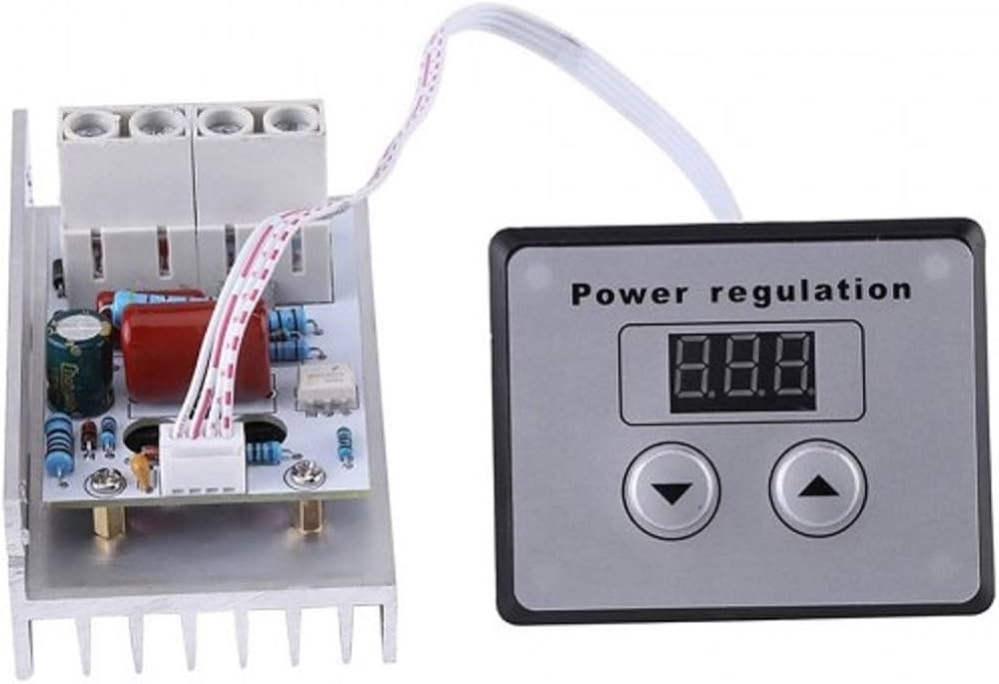





10000W Original Chips Thyristor Super Power Electronic Regulator can Change Light Speed and Temperature
The 10000W Original Chips Thyristor Super Power Electronic Regulator you're referring to seems like a high-power electronic component that could be used to regulate and control the speed of lights, heating elements, or other electrical systems, particularly in the context of adjusting power delivery. Here's an outline of how such a device might work and what its potential features could be based on the description:
₹ 1,099 ₹1,399
1,399



| Made In : | India |
Add FAQ
The 10000W Original Chips Thyristor Super Power Electronic Regulator you're referring to seems like a high-power electronic component that could be used to regulate and control the speed of lights, heating elements, or other electrical systems, particularly in the context of adjusting power delivery. Here's an outline of how such a device might work and what its potential features could be based on the description:
Key Features and Functionality:
-
Thyristor-Based Power Regulation:
- Thyristors are solid-state semiconductor devices that act as a switch for high-voltage/current applications. They allow for precise control of power to electrical loads.
- The term “Super Power Electronic Regulator” implies the use of these thyristors to regulate very high power levels (like the 10,000W rating) with high efficiency and low heat dissipation.
-
10000W Power Rating:
- The 10,000W (10kW) power rating indicates that the regulator can handle very high loads, suitable for large systems or industrial applications, such as powerful lights, heating elements, motors, etc.
- Such a high power rating would be useful for applications like industrial heating systems, high-intensity lighting, or large LED setups.
-
Adjusting Light Speed:
- The mention of "light speed" might be metaphorical, referring to the ability to control the intensity or brightness of lights. This could be achieved by adjusting the power supplied to light sources (like LED or halogen lights).
- It's also possible that the "speed" refers to the speed of a device's response to changes in input power (like dimming speed for LED lights).
-
Adjusting Temperature:
- The temperature adjustment could refer to the control of heating elements, such as industrial heaters or electrical ovens. By regulating the amount of power going to the heating elements, the device can control the temperature.
- This could be especially useful in thermal management applications, such as soldering equipment, furnaces, or temperature-sensitive processes.
-
Original Chips:
- The term "Original Chips" suggests that the device uses high-quality, possibly proprietary components, to ensure reliable and efficient operation. This is especially important in high-power applications where stability and precision are crucial.
Typical Applications:
- Industrial Lighting: Controlling powerful lights (like stage lights, high-bay lights, or large-scale LED systems).
- Temperature Control Systems: Regulating temperature in heating systems, furnaces, or ovens.
- Laboratory Equipment: Precise control of heating elements or power for experimental setups.
- Motor Speed Control: If it's a thyristor-based controller, it could potentially be used for adjusting the speed of AC motors by varying the power supplied.
- Audio/Visual Equipment: Adjusting brightness or intensity of large-scale projectors, spotlights, or lights used in studios and theaters.
How It Works:
-
Power Regulation with Thyristors: A thyristor acts as a switch that turns on and off very quickly. By adjusting the point at which the thyristor is triggered in each cycle, it can control the amount of power delivered to a load. This method of regulation is highly efficient because thyristors generate little heat compared to traditional resistive methods of dimming or power regulation.
-
Light Speed Control: If this device is used for lighting, it likely adjusts the brightness by rapidly switching the current to the light source on and off, effectively dimming the light. The term "light speed" could refer to how quickly these adjustments can be made or how smoothly the light output can be varied.
-
Temperature Control: If used for heating, the regulator would change the amount of time the power is supplied to the heating element during each cycle, adjusting the temperature of the load. The regulator can be finely tuned for precise temperature control by varying the power at the right times.
Possible Features:
- Adjustable Output: The regulator might offer a dial or digital control to adjust the power output, either controlling temperature or light intensity.
- Feedback Mechanism: There could be sensors for real-time feedback to adjust power to maintain a stable output (e.g., temperature sensors or light sensors).
- Overload Protection: With 10,000W of power at stake, safety features such as overload protection, thermal shutdown, and short-circuit protection would likely be included.
- Cooling System: High-power thyristors often require additional cooling, so the module might include heat sinks or active cooling mechanisms like fans.
Conclusion:
The 10000W Original Chips Thyristor Super Power Electronic Regulator would likely be a robust and high-power device designed to regulate both light intensity and temperature for industrial or professional applications. By using thyristor-based regulation, it ensures efficiency and precision while handling large loads. If you're planning on using this in an application, you'll want to ensure it’s properly rated for your specific voltage, current, and load requirements.
If you have more specific details about the device (e.g., input/output specifications or more context for the "light speed"), I could give a more tailored answer!
0 Reviews For this Product









2.jpeg&width=225&quality=80)
2.jpeg&width=225&quality=80)
.jpeg&width=225&quality=80)

